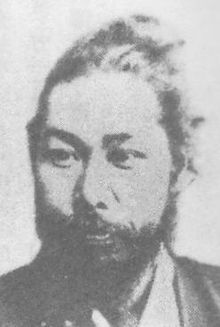Miyazaki kittens
Miyazaki Tōten ( Japanese 宮 崎 滔天 ; born January 23, 1871 in Arao , Higo Province ; † June 12, 1922 ) was a Japanese political activist, Panasianist , philosopher and in later years under the stage name Tōchūken Ushiemon ( 桃 中 軒 牛 右衛門 ) also Naniwa-bushi singer. He is best known as a friend and supporter of the Chinese revolutionary Sun Yat-sen .
Childhood and youth
Miyazaki Tōten grew up in a Gōshi family in what is now Kumamoto Prefecture in the countryside. His real name was Miyazaki Torazō ( 宮 崎 虎 蔵 or 宮 崎 寅 蔵 ).
First he attended the Ōe school, which was run by Tokutomi Sohō . After his eldest brother Hachirō ( 宮 崎 八郎 ; 1851–1877) had been killed by government troops during the Satsuma rebellion , he began to be influenced by reports of the French Revolution for revolutionary theories and the movement for civil rights and freedom . His two older brothers Tamizō ( 宮 崎 民 蔵 ; 1865-1928) and Yazō ( 宮 崎 弥 蔵 , historically : 宮 崎 彌 蔵 ; 1867-1896) were also active in this movement. From 1886 Miyazaki Tōten attended the Tōkyō semmon gakkō (later Waseda University ) in Tokyo , where he began to deal increasingly with politics.
Life and work in the Pan-Asian movement
In 1887 Miyazaki converted to Christianity, but turned away from the Christian faith after only two years, disappointed. Instead, he developed a passion for the revolution that would free Asia from the yoke of the white man. To pursue this goal he traveled to Shanghai in 1891 to support the Chinese revolutionaries in their struggle against the rule of the Manchu . However, due to lack of money, he soon had to return to Japan, where he met the Korean reformer Kim Ok-gyun in Tokyo in 1894 shortly before his murder.
In the years that followed, Miyazaki turned to promoting Japanese immigration to Siam for a while . After a few years, however, this project also failed. After his return to Japan in 1897 , through the mediation of his sponsor and friend Inukai Tsuyoshi, he met the Japanese Foreign Minister Ōkuma Shigenobu , from whom he received financial support from secret funds of the ministry, in order to establish contacts with Chinese reformers. Due to an illness, Miyazaki was unable to make the planned trip to China.
A short time later he met through his brother Yazō Sun Yat-sen and other Chinese revolutionaries who were staying in Japan at the time. Deeply impressed by Sun, Miyazaki stepped up his efforts to unify Asia, which he believes would require the overthrow of Manchu rule. In 1905, Miyazaki, together with Sun Yat-sen and other exiles in Tokyo, founded the Tongmenghui , which dedicated itself to the expulsion of the Manchu emperors and the establishment of a Chinese republic. Another joint project with Sun Yat-sen in 1899 was to support the Filipino freedom fighters around Emilio Aguinaldo with weapons.
From 1907 Miyazaki published the magazine Kakumei Hyōron ("Critical Revolutionary Magazine"), which was founded to support the revolution in China and to eliminate the Manchu foreign rule . In 1917, young Mao Zedong wrote a letter asking him to give a lecture.
Unlike other Japanese Panasianists, Miyazaki was not interested in expanding into the Asian continent. Rather, in his eyes, only a strong China could withstand the advance of the West. His enthusiastic support for the Chinese Xinhai Revolution arose from his belief in democracy and social equality, as well as the hope that Japan would be able to maintain independence and implement reforms.
After his health deteriorated steadily from around 1913, he gradually reduced his commitment to the Chinese revolutionaries. In 1915, however, he was a candidate for the Japanese parliamentary elections. Although he was supported by influential figures of the Pan-Asian movement such as Tōyama Mitsuru and Professor Terao Tōru as well as Inukai Tsuyoshi, he did not manage to win a seat in parliament. In the last few years of his life, he made a living writing columns for newspapers. He died in 1922 at the age of 52.
Works
Miyazaki never held an official position, but wrote many articles for newspapers and magazines. At the age of 33 he published his autobiography Sanjūsannen no Yume (My 33-year-old dream) in 1902 , in which he presented his idealistic-romantic ideas of a united Asia. This work is one of the most important sources not only for the life of Miyazaki itself, but also for the life of Sun Yat-sen and the 1911 revolution.
literature
- Marius B. Jansen: The Japanese and Sun Yat-Sen , Cambridge 1954
- Christopher WA Szpilman: Miyazaki Tōten's Pan-Asianism, 1915-1919, in: Sven Saaler and Christopher WA Szpilman (eds.): Pan-Asianism. A Documentary History . Vol. 1, New York 2011, pp. 133-140.
- Takeuchi Yoshimi (ed.): Ajiashugi [Asianism] (Gendai Nihon Shisô Taikei, 9), Tôkyô: Chikuma Shobô 1963.
- Stuart R. Schram (Ed.): Mao's Road to Power: Revolutionary Writings 1912-1949 , Volume 1, Armonk 1992.
Web links
Individual evidence
- ^ Marius B. Jansen: The Japanese and Sun Yat-Sen, Cambridge 1954, p. 65.
- ↑ Stuart R. Schram (Ed.): Mao's Road to Power: Revolutionary Writings 1912-1949, Volume 1, Armonk 1992, p. 111
- ^ A b Joshua Fogel: Sun Yat-sen's 1911 Revolution had Its Seeds in Tokyo, in: Japanfocus (November 23, 2007) [1]
| personal data | |
|---|---|
| SURNAME | Miyazaki, kittens |
| ALTERNATIVE NAMES | 宮 崎 滔天 (Japanese); Miyazaki Torazō (real name); 宮 崎 虎 蔵 (Japanese, real name); 宮 崎 寅 蔵 (Japanese, alternative spelling); Tōchūken Ushiemon (stage name); 桃 中 軒 牛 右衛門 (Japanese, stage name) |
| BRIEF DESCRIPTION | Japanese Panasianist, philosopher, friend of the Chinese reformer Sun Yat-sen |
| DATE OF BIRTH | January 23, 1871 |
| PLACE OF BIRTH | Arao , Higo Province |
| DATE OF DEATH | June 12, 1922 |
